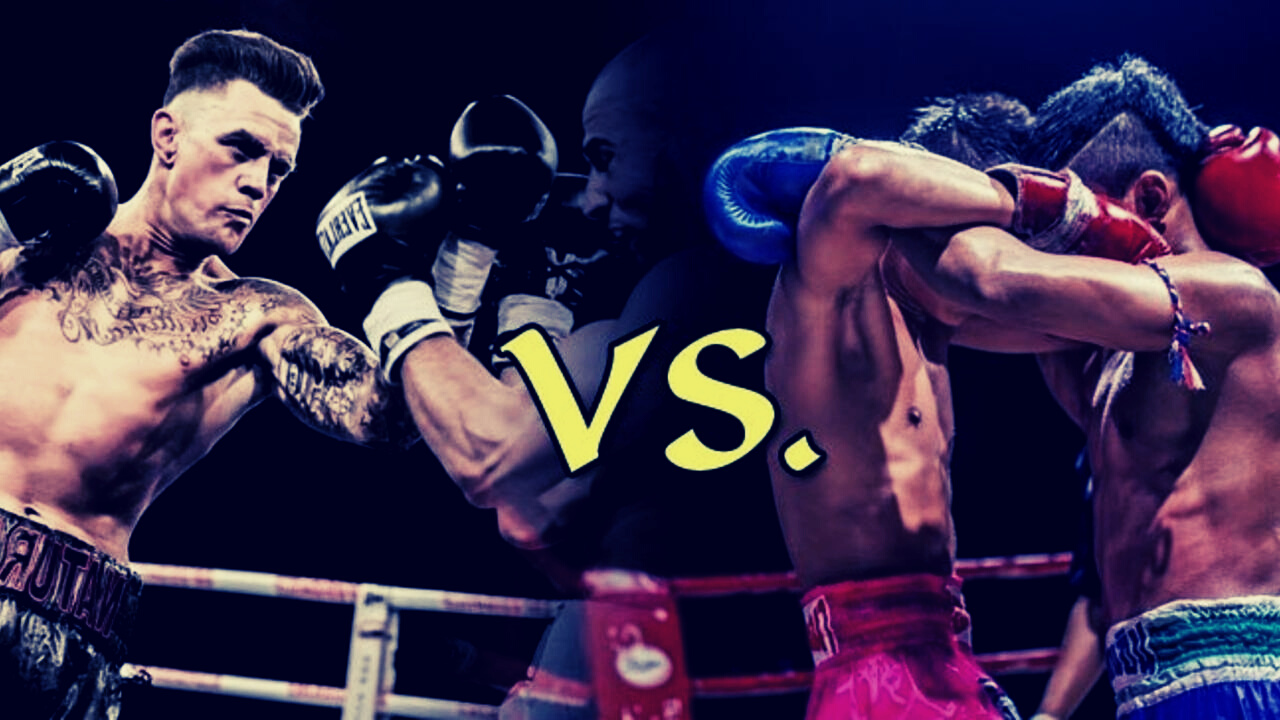Comparing Kickboxing vs. Muay Thai

THE MAIN DIFFERENCES BETWEEN TWO "SISTER SPORTS"
By Angela Chang
With both kickboxing (K1 rules) and Muay Thai growing simultaneously around the world, fans of one sport are often fans of the other.
With many Muay Thai fighters successfully making the transition over to kickboxing (such as Sitthichai, Petchpanomrung, Tiffany van Soest, and many more), it’s easy to think they are the same.
While there are many similarities between the two, there are a few things that set Muay Thai apart from kickboxing.
1. Kicks to Punches Ratio
When you watch a professional Muay Thai fight, punches are usually only used to set up kicks and knees. Less commonly, some Muay Thai fighters will have the Muay Maat style and attempt to knock out their opponents with punches instead fighting to win on points.
However, you will see much much more punches being thrown in a kickboxing fight, often in long combinations or with the “haymaker” style of throwing bombs. This boils down to the differences in scoring.
In Muay Thai, if you don’t kick, you will not win unless you knock out your opponent with something else. In traditional Muay Thai, middle kicks are scored the highest, followed by knees, elbows, then punches. Someone can throw 50 punches in a round and the other person can throw 10 kicks in a round and the person throwing the kicks will win. Punches are scored more significantly when someone has their opponent against the ropes and is doing visible damage to them with the punches.
Kickboxing, on the other hand, scores effective strikes pretty evenly – punches, kicks, and knees. A light jab is not weighted the same as a solid low kick, but hard punches that back up the opponent score on the same level as a kick. This is why you may see people fighting with flurries of punches. This is not often seen in Muay Thai unless the fighter is sure he can get the KO with punches.
2. Clinch, Dumps, Sweeps & Catches
Clinching is allowed in both. Yes, you read that correctly.
Clinching is a vital part of Muay Thai, which is well known. However, a lot of people are under the impression that you are not allowed to clinch under K1 rules, which is not true.
You are able to clinch, but only for a short amount of time, and you usually must break after 1 strike. Entire rounds of clinching will not be seen in a kickboxing fight, and some fighters are given warnings if they attempt to clinch for longer than allowed. This is perhaps why some fighters who fight under K1 rules still clinch, so they know how to effectively close the distance and do damage with a knee or two.
Also, if you have no idea how to clinch and someone grabs you to hurt you with a knee, you will most likely stand there and take it because you don’t know how to react.
Dumps and sweeps are wonderful off-balance techniques that can be used in the clinch or when catching a kick, but ONLY during a Muay Thai fight. None of these are allowed in kickboxing rules (although Kunlun Fight now allows leg catching and sweeping). In virtually all other kickboxing fights, you are not allowed to dump nor sweep your opponent, and you are not allowed to catch kicks at all.
3. Muay Thai vs. Kickboxing Stances
Although stances differ from fighter to fighter in Muay Thai, and fighter to fighter in kickboxing, there are some major differences between the stance of a Muay Thai fighter and the stance of a kickboxing fighter.
Muay Thai fighters generally have their elbows out more in order to throw elbows and to block kicks with their shins without elbowing their thigh.
Because of the usual high volume of punches being thrown and received in a kickboxing fight, kickboxing fighters generally have their elbows glued to their ribs. This helps to protect themselves from body shots and to help them box more. Also, there are no elbows under kickboxing rules, so they don’t have to utilize a guard with their elbows out.
On a similar note, kicks to the arm sometimes count as “blocks” in the kickboxing world, so some fighters will not attempt to block with their shin like Muay Thai fighters do. In Muay Thai, a kick to the arm allows the opponent to score. This is another reason to add to the difference in stances.
4. Fight Pace
Most kickboxing fights are 3 rounds unless they are title fights, whereas most Muay Thai fights are 5 rounds.
In a kickboxing fight, every single round counts, so it is fought at a much higher pace than a Muay Thai fight.
In Muay Thai (in Thailand), the first two rounds “don’t count” and is often called the “feeling out” process. The third and fourth rounds are the rounds that most of the action is in, with the fourth round weighed the most. The fighters only engage seriously in the fifth round if it is a close fight or if the losing fighter is looking to knock out his/her opponent to secure the win. The fighter ahead on points will usually dance around the ring or keep their opponent from scoring with teeps and evasion techniques.
In 3-round Muay Thai fights, every round counts but the first round is often a “feeling out” round.
5. Culture/Music
Muay Thai has a tremendous amount of culture behind it and it is extremely evident in how the shows are structured. There is usually a lot of respect between the fighters. They wai to each other before and after the fight. Muay Thai fighters often walk into the ring with at least a mongkol on their head and prajioud on their arms. They perform wai kru ram muay to pay respect to their gym and trainers.
This tradition is not usually seen on kickboxing shows unless the fighter made the transition from Muay Thai. Even then, it will only be the fighter wearing just the mongkol walking into the ring. Wai kru ram muay is usually not allowed to be performed at kickboxing shows as it is not a Muay Thai fight.
During the fight, a Muay Thai fight will play traditional fight music, and there might even be someone with a microphone commenting on the fights out loud – it can get pretty loud with those things happening and with the coaches screaming! But most kickboxing shows are pretty quiet with the exception of the cornering that is going on.
6. Technicality and “Beauty” of the Fight
Flashy techniques, especially with kicks, that show athleticism can win the judge’s favor in a kickboxing fight, so techniques from different martial arts will be seen.
In Muay Thai, what is revered more is a “beautiful” fight, where the fighter is composed, has a good fighting stance, and picks effective shots instead of coming in rushing. The “rushing” can be seen often in professional kickboxing fights, mostly because of the pressure of the high pace.
What is sometimes seen as “action packed” in a kickboxing match will be called “sloppy” with no hesitation by a Muay Thai trainer. Composure is very important, especially to the Thais, and they love a technical fighter over a sloppy aggressive one. This means that most of them stick to basics and avoid the flashy spinning kicks.
Muay Thai vs. Kickboxing: The Fight That Changed The World
This bout forever changed the landscape of kickboxing, Muay Thai, and MMA in North America. You’ll find no other fight that is as dramatic, with both fighters displaying tremendous heart.

Feed Your Muay Thai Addiction!
Join our "Muay Thai Mondays" email newsletter for the latest updates on new videos, special events and everything Muay Thai!







